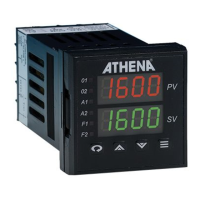38
Display Parameter Available Selections
dPng
Low
Lo - low damping - fast recoveryReverse acting (heating)
Normal
nL - Direct acting (cooling).
High
Hi - Reverse acting (heating).
The damping parameter specifies how aggressively the controller performs its autotuning. The “Normal”
setting is a compromise between the fast recovery and overshoot. The “Low” setting provides faster recovery,
but with the possibility of overshoot; the “High” setting a slower recovery, but with minimum or no overshoot.
tunE
dPng
Tuning a temperature controller involves setting the proportional, integral, and derivative values to get the
best possible control for a particular process. If the controller does not include an autotune algorithm, the unit
must be tuned using trial and error. To further explain the autotune process, here are some key definitions:
1) - Also known as duty cycle; the total length of time for the controller to complete one on/off
cycle. For example: a 20 second cycle time, has an “on-time” of 10 seconds and an “off-time” of 10 seconds
and represents a 50 percent power output. The controller will cycle on and off while within the proportional
band.
2) - A temperature band expressed in % of fullscale, or degrees, within which the
controller‘s proportioning action takes place. The wider the proportional band, the greater the area around
the setpoint in which the proportional action takes place. This is sometimes referred to as gain,which is the
reciprocal of proportional band.
3) also known as reset, is a function which adjusts the proportional bandwidth with respect to
the setpoint to compensate for offset (droop) from setpoint; that is, it adjusts the controlled temperature to
setpoint after the system stabilizes.
4) , also known as rate, senses the rate of rise or fall of system temperature and automatically
adjusts the proportional band to minimize overshoot or undershoot.
Athena’s PID (three mode) controllers are capable of exceptional control stability when properly tuned
and used, allowing operators to achieve the fastest response time with the smallest overshoot. The
information for tuning this three mode controller may be different from other controller tuning procedures.
Normally a SELF TUNE feature will eliminate the need to use this manual tuning procedure for the primary
output;however, adjustments to the SELF TUNE values may be made if desired.

